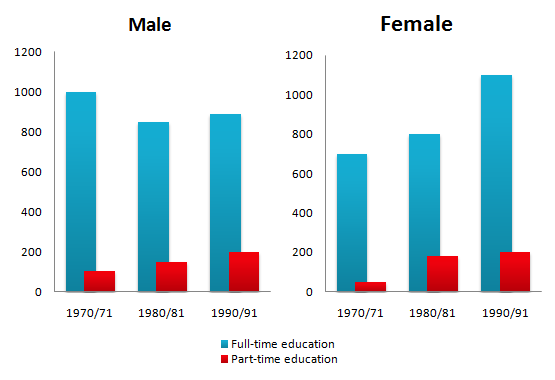Hello, everyone. Can somebody give me a band, please? (IELTS writing task 1 requirements)
Thank youfor reading my essay. :))
TOPIC:
The chart below shows the number of men and women in further education in Britain in three periods and whether they were studying full-time or part-time.
Summarise the information by selecting and reporting the main features, and make comparisons where relevant.
Write at least 150 words.
The bar chart illustrates the amount of males and females in extra education in Britain in the years 1970/71, 1980/81 and 1990/91, and who of them were studying part-time or full-time.
In general, in male diagram, full-time education fluctuated slightly and part-time increased over the 20-year period, while in female chart, both, full-time and part-time education rose.
In men statistics, it can be seen that full-time started from 1 million men in 1970/71 and by 1980/81, it had decreased by over 100 thousands males. In the years 1990/91, full-time education rose negligible. However, part-time started from just under 100 thousands males and had a little increase in 1980/81. By 1990/91, it had jumped over 200,000 men.
Females data only went up over the period. Full-time education started from approximately 700 thousands women in 1970/71 and rose by about 100,000 females in the years 1980/81. By 1990/91, it had dramatic jump up to 1.1 million women. Otherwise, part-time education in 1970/71 had only 30,000-40,000 women and by 1980/81, it had increased by over 150 thousands females. In the years 1990/91, the number of women attending part-time education grew up to 200 thousands.
Thank youfor reading my essay. :))
TOPIC:
The chart below shows the number of men and women in further education in Britain in three periods and whether they were studying full-time or part-time.
Summarise the information by selecting and reporting the main features, and make comparisons where relevant.
Write at least 150 words.
The bar chart illustrates the amount of males and females in extra education in Britain in the years 1970/71, 1980/81 and 1990/91, and who of them were studying part-time or full-time.
In general, in male diagram, full-time education fluctuated slightly and part-time increased over the 20-year period, while in female chart, both, full-time and part-time education rose.
In men statistics, it can be seen that full-time started from 1 million men in 1970/71 and by 1980/81, it had decreased by over 100 thousands males. In the years 1990/91, full-time education rose negligible. However, part-time started from just under 100 thousands males and had a little increase in 1980/81. By 1990/91, it had jumped over 200,000 men.
Females data only went up over the period. Full-time education started from approximately 700 thousands women in 1970/71 and rose by about 100,000 females in the years 1980/81. By 1990/91, it had dramatic jump up to 1.1 million women. Otherwise, part-time education in 1970/71 had only 30,000-40,000 women and by 1980/81, it had increased by over 150 thousands females. In the years 1990/91, the number of women attending part-time education grew up to 200 thousands.

kio_nie.png
